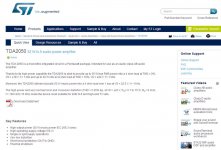No wonder they refused my order !!!!
Although their website shows that it is still active!!
jer
It is typical for manufacturers not to show parts as obsolete immediately. However, Mouser now shows these ICs at EOL (end of life) and DigiKey sent me this:
Dear Valued Digi-Key Customer,
You have purchased the following part number from Digi-Key within the last two years. The manufacturer has announced an update to the part status.
Part Affected
Manufacturer STMICROELECTRONICS
Description IC AMP AUDIO PWR HIFI PENTAWATT5
Manufacturer Part Number TDA2050V
Digi-Key Part Number 497-3028-5-ND
Status Obsolete
Last Time Buy Date Undefined By Supplier
Substitutes Please click here
TDA2003 is the most popular ic used in generic (china made) tv boards. They are quite rugged, with two 16-ohm or 8-ohm speakers connected in parallel.
Here at our local supplier they still have lots of TDA chips as they are very popular as I have said. I will be building myself some TDA7293/TDA7294 amps next week, just to compare notes/sound with my stk4172 and stk4182 amps. I have lots of stk amps i salvage from junks, and with some modifications they still are usable.
Here at our local supplier they still have lots of TDA chips as they are very popular as I have said. I will be building myself some TDA7293/TDA7294 amps next week, just to compare notes/sound with my stk4172 and stk4182 amps. I have lots of stk amps i salvage from junks, and with some modifications they still are usable.
That was my thought when I read this news... there's a supply glut, new sales have dropped, and ST is directing their production resources elsewhere.Here at our local supplier they still have lots of TDA chips as they are very popular as I have said.
I wanted to get a TDA2050 to replace the TDA2030 in my Park amplifier to give it a boost!!!
I guess I better jump on it before they are gone!!!!
jer
Your not going to give it a boost unless you also give your PSU a boost ...
I wanted to get a TDA2050 to replace the TDA2030 in my Park amplifier to give it a boost!!!
I guess I better jump on it before they are gone!!!!
jer
It will put out the *exact* same power as before.
Easy to figure: you pull TDA2030, put TDA2050 there, power available to the load stays the same.
The amplifier does not generate power, it's just the "tap" which lets the "water" out.
If you have a 14 liter tank, putting a 32 or 50 liter rated tap will still be able to supply 14 liters of water.
This is an analogy, of course.
As of
The amplifier does not generate power, it's just the "tap" which lets the "water" out.
If you have a 14 liter tank, putting a 32 or 50 liter rated tap will still be able to supply 14 liters of water.
This is an analogy, of course.
As of
, what does it mean?I already have a bigger transformer that I can use for it for it.
I am not a newbie when it comes to power amplifiers and their supply requirements.
The 2030's and the 2050's have the same pinout and this would make for a very easy mod of just swapping the chip with the addition of a higher voltage supply via separate transformer.
The preamp section has enough voltage swing to send the TDA2030 into clipping oblivion so this won't be an issue for driving the TDA2050 using the existing circuit.
I typically use a 4 ohm load on it as well.
jer
The 2030's and the 2050's have the same pinout and this would make for a very easy mod of just swapping the chip with the addition of a higher voltage supply via separate transformer.
The preamp section has enough voltage swing to send the TDA2030 into clipping oblivion so this won't be an issue for driving the TDA2050 using the existing circuit.
I typically use a 4 ohm load on it as well.
jer
Last edited:
The TDA2050 does have one little trick up its sleeve. Its output devices are optimized for a little better voltage swing so it can produce a watt or two over the earlier ICs at the same supply voltage. However, the logarithmic nature of sound and hearing would make this gain in power practically impossible to hear, so JMFahey is correct.
before adding voltage be sure the external components can take it and you will likely need a larger heatsink.
The Chinese counterfeit TDA2050s have poor output swing and fall 3 to 4 watts short of the authentic ones. The on chip protection is dubious as well.
Let's not forget we still have the very good LM1875 around (for now).
before adding voltage be sure the external components can take it and you will likely need a larger heatsink.
The Chinese counterfeit TDA2050s have poor output swing and fall 3 to 4 watts short of the authentic ones. The on chip protection is dubious as well.
Let's not forget we still have the very good LM1875 around (for now).
TDA2003 is the most popular ic used in generic (china made) tv boards. They are quite rugged, with two 16-ohm or 8-ohm speakers connected in parallel.
Over its supply voltage range, it could handle under 2 Ohm loads. It was initially designed for the car stereo market. It was the successor of the TDA2002. National released the LM383, so SGS, not to be out done, followed up with the TDA2003 which had improved output voltage swing for a bit more power.
The 2002/2003 was designed by Bruno Murari who is well respected for linear IC design. Google "The LM383 Story". The National engineer who designed that chip discusses all the issues in creating such an IC and admits that it is essentially a copy of the TDA2002. The National engineers had respect for Bruno.
OK, so just to "awaken" a 5 year old discussion, with ALL other circuit components untouched, including the PSU, substituting a 2030 with a 2040 or even a 2050 (if one can still find one) will NOT produce any discernible increase in output power. Correct? So in order to produce a few watts extra, simply swapping in a beefier PSU will do the trick and by beefier what exactly do we mean? Also, if a higher voltage will do the trick, don't we -then- have to "beef up" some/most/all of the other supporting components? Can somebody clarify this once and for all - Thank you !!!
A TDA2040 or TDA2050 may give a bit more output power than a TDA2030, with the same supply voltage, because the output stage drivers in the TDA2040/2050 (more recent design) may be able to pull the output further toward the supply rails. The gain in power will not be much.
A higher supply voltage (and higher current rating) will allow the sine-wave to be generated from a higher voltage. You can imagine the power supply rails to be the floor and ceiling in a room and then imagine how high the sine-wave, standing on the floor, can be before touching the ceiling. When it touches the ceiling, you have "clipping". More height -> a larger sine-wave and more power (increases with the square on the height).
All components need to be adapted to the voltage (and current) they operate at. Any well designed amplifier has reliability margins for voltage and current of the components. How much depends on each amplifier. If not enough, you either have to leave the supply voltage below safe operating conditions for all components or start changing ("beef up") components.
A higher supply voltage (and higher current rating) will allow the sine-wave to be generated from a higher voltage. You can imagine the power supply rails to be the floor and ceiling in a room and then imagine how high the sine-wave, standing on the floor, can be before touching the ceiling. When it touches the ceiling, you have "clipping". More height -> a larger sine-wave and more power (increases with the square on the height).
All components need to be adapted to the voltage (and current) they operate at. Any well designed amplifier has reliability margins for voltage and current of the components. How much depends on each amplifier. If not enough, you either have to leave the supply voltage below safe operating conditions for all components or start changing ("beef up") components.
Last edited:
Thank you for accepting my post and the fast reply. For some reason, I am going on a limb here by asking rudimentary questions, but also because I do not mean to hijack the thread, although it is a very old one. I can start a new thread if needed. Please let me know.
So, I inherited a broken Behringer AT108 acoustic instrument combo amplifier. When turned ON it makes a continuous booming low frequency noise and I noticed the speaker cone moves all the way to the back and does not come at the resting (mid) position unless I turn it off.
I looked inside it is based on a TI074C and a D2030A. I happen to have a 2030 laying around so I will just try to replace that and see what happens. I also tested the PSU and (I think it is working fine) it produces 13.4V AC between the brown wire and any of the two yellow wires, while between the two yellows I read (as expected) double that, eg 26.8V AC. Now I have no sure way to measure how much DC actually reaches the power amp, so what I'll do is when I remove the IC I will turn on and measure at pads (pins) 3 and 5. I expect to read around 30-35V DC. I hope I won't make things worse, but my hunch is it's just the power amp IC is bad which should be an easy repair. What do you think?
And finally,
1. What other component(s) around the power amp IC should I check before I replace it. I am afraid whatever caused the bad IC will again "fry" the new 2030 as well. Could the 2030 have gone bad on ...its own?
2. Given the attached datasheets, it looks as if the 2040 is a pin for pin replacement for the 2030 and assuming the provided voltage is around 30V DC, without any other circuit modifications, it will produce about 20W a nice improvement from the claimed stock of 15W. Am I correct about this?
Thank you for your help! Let's see if with your help I can resurrect this little amp!?
So, I inherited a broken Behringer AT108 acoustic instrument combo amplifier. When turned ON it makes a continuous booming low frequency noise and I noticed the speaker cone moves all the way to the back and does not come at the resting (mid) position unless I turn it off.
I looked inside it is based on a TI074C and a D2030A. I happen to have a 2030 laying around so I will just try to replace that and see what happens. I also tested the PSU and (I think it is working fine) it produces 13.4V AC between the brown wire and any of the two yellow wires, while between the two yellows I read (as expected) double that, eg 26.8V AC. Now I have no sure way to measure how much DC actually reaches the power amp, so what I'll do is when I remove the IC I will turn on and measure at pads (pins) 3 and 5. I expect to read around 30-35V DC. I hope I won't make things worse, but my hunch is it's just the power amp IC is bad which should be an easy repair. What do you think?
And finally,
1. What other component(s) around the power amp IC should I check before I replace it. I am afraid whatever caused the bad IC will again "fry" the new 2030 as well. Could the 2030 have gone bad on ...its own?
2. Given the attached datasheets, it looks as if the 2040 is a pin for pin replacement for the 2030 and assuming the provided voltage is around 30V DC, without any other circuit modifications, it will produce about 20W a nice improvement from the claimed stock of 15W. Am I correct about this?
Thank you for your help! Let's see if with your help I can resurrect this little amp!?
Attachments
-
 Behringer AT108 (1).jpg124.1 KB · Views: 290
Behringer AT108 (1).jpg124.1 KB · Views: 290 -
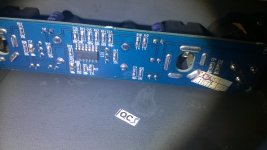 Behringer AT108 (2).jpg265.9 KB · Views: 279
Behringer AT108 (2).jpg265.9 KB · Views: 279 -
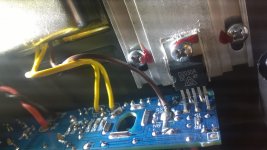 Behringer AT108 (3).jpg256.6 KB · Views: 285
Behringer AT108 (3).jpg256.6 KB · Views: 285 -
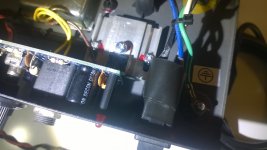 Behringer AT108 (4).jpg218.2 KB · Views: 305
Behringer AT108 (4).jpg218.2 KB · Views: 305 -
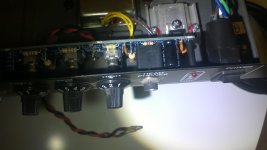 Behringer AT108 (5).jpg181.2 KB · Views: 251
Behringer AT108 (5).jpg181.2 KB · Views: 251 -
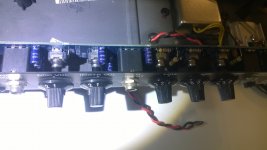 Behringer AT108 (6).jpg179.4 KB · Views: 79
Behringer AT108 (6).jpg179.4 KB · Views: 79 -
074C, 2030, 2040 Data Sheets.pdf154.6 KB · Views: 64
- Status
- This old topic is closed. If you want to reopen this topic, contact a moderator using the "Report Post" button.
- Home
- Amplifiers
- Chip Amps
- A sad day for 5 pin chip amps
